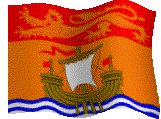
John Robertson was appointed mayor of Saint John in 1836
The great Lumber Baron, Alexander Rankin, died on Apr. 3/1852
March of 1848 saw the City of Fredericton Incorporated.
March of 1837 saw Carleton County established.
April 1890 saw the first Acadian judge elected (P. A. Landry)
April 1845, Queen Victoria declares Fredericton a city
May of 1856 saw the Town of Woodstock incorporated
The first libel case in NB was in 1786
The first potatoe digger was patented in 1845 by William Watts
Frederiton was the site of the conspiracy trial of John Baker in 1828
The first Loyalist ships arrived in Saint John in May of 1783
The first Attorney-General of New Brunswick was Johathan Bliss in 1785
May of 1871, the Town of St Stephen was incorporated
May 1868, New Brunsiwck's Coat of Arms was assigned by Royal Warrant
Capt. William Owens of The Royal Navy landed at Campobello Island in June of 1770
June 1622, Sir William Alexander sends Scottish colonists to Acadia
The first Daily Mail service between Saint John and Halifax took place June 1859
The first brick building was built in Saint John in 1817
June 1790, Elias Hardy was appointed clerk of the Saint John Common Council
Fort Cumberland gets its name from General Monckton after he captured it in 1755 it was called Fort Beausejour up until then
One of the first Lumber Barons of the Miramichi, William Davidson, died June 18/1790
June 18/1784, Saint John was the site of a bad fire
A suspension wire bridge was built over the Reversing Falls in Saint John, construction began in 1851 and it was in use until 1913
June of 1899, Town of New Castle is incorporated
In June of 1497, great explorer John Cabot landed in Canada
And on June 24th of 1604, Samuel de Champlain explored the mouth of a river he named The St John, after St John the Baptist
The Kerosene lamp was patented by Abraham Gesner in June of 1854
July of 1760 saw the Battle of the Restigouche off of Campbellton NB, the last battle between the French and the English for supremacy.
July of 1827, John Baker hoisted the U.S. flag in Upper Madawaska county and asked for union with Maine U.S.
July 1854 was the month of the Cholera epidemic in Saint John
The Bay des Chaleurs was named by Jacques Cartier when he sailed there in 1534
King Charles The First, granted Nova Scotia to Sir William Alexander in 1625
The Legislature moved from Saint John to its present place in Fredericton in 1788
The Battle of the Bull Run in the American Civil War, was the host of a soldier of a different suit, in 1861 as Sarah Emma Edmunds of Magaguadavic disguised as a man served in it..
Aug. 1689, John Gyles was captured by the Maliseets
Partridge Island got its first Operational Lighthouse in 1791
Article found in the "Courrier": Sept. 2/1848, "We regret to state that Capt. George Briggs of the ship "Ann Dashwood" of this port, met with a serious accident last night by falling from the deck into the ship's hold. Capt. Briggs is the eldest surviving son of James Briggs of Portland. He was a man of great promise". He had just sailed in from Liverpool with a cargo of salt and coal.
The city of Saint John was named Parr Town, in 1783, in honor of Governor Parr of Nova Scotia. It got its present name of Saint John on May 18/1785.
Paul Bedell, laid out the plan of the city, dividing it in 1454 lots
1785 was also the year of the first newspaper of New Brunswick, called "the Royal Gazette and New Brunswick Advertiser"
Honorable G. Ludlow was Saint John's first mayor
Saint John's Great Cathedral of the Immaculate Conception, had its corner stone blessed on April 25/1853, The spire was only erected in 1872.
In 1805 The Saint John Grammar school was opened
In York County, a little village called Jewett's Mills, was founded by Daniel Jewett in 1804.
following the rising of the waters caused by the Mactaquac Hydro Development, it dissapeared forever in 1967
The present NB Museum, in Saint John, was formed at first as a private Museum by Abraham Gesner in 1842
In 1837 again 115 homes and practically all the business section burnt
Nearly 3000 people were made homeless again in 1839 by fire
And again in 1841 fire destroyed many homes
Again on June 20/1877, Saint John fire leaves 2,700 families and 13,000 homeless
**I will try to get more history of Partridge Island as it is most interesting even to visit today. It was the site where all the sick (ship-fever epidemics, cholera etc..) immigrants coming into the port of Saint John, NB, were left off by the ships and thousands died and are buried there.. when visiting this little Island just off the Port of Saint John, there are restricted areas, you can only walk where it is indicated you can, supposedly for fear of bacterial remnants of some sorts of these epidemics **
In 1847 alone, Newspaper articles read "600 sick Immigrants at Partridge Island with Immigrant Fever" , "29 Deaths at Immigrant Hospital near the Alms House", "32 deaths at Partridge Island". In 1847, 15,000 Immigrants landed on Partridge Island and of those 2,000 died of fever. and over 800 died before even reaching the port of Saint John.
Saint John's first Roman Catholic mass was held at Marquet Square, City Hall in 1813
The Waterloo street Baptist Church was active in 1842
St Mary's Episcopal Church had its corner stone laid in May of 1861
Saint John's first Episcopal church was first used in 1791